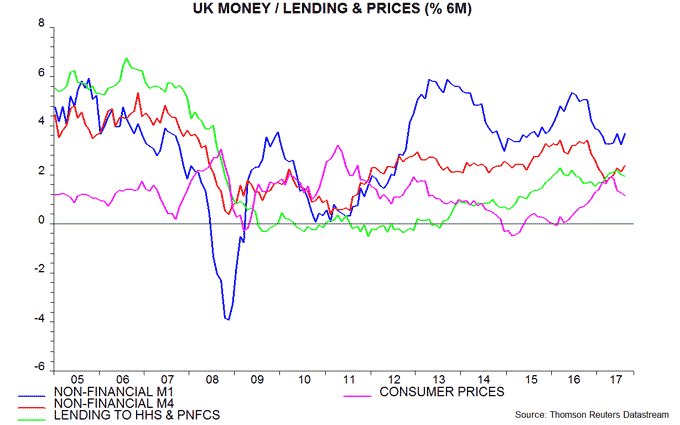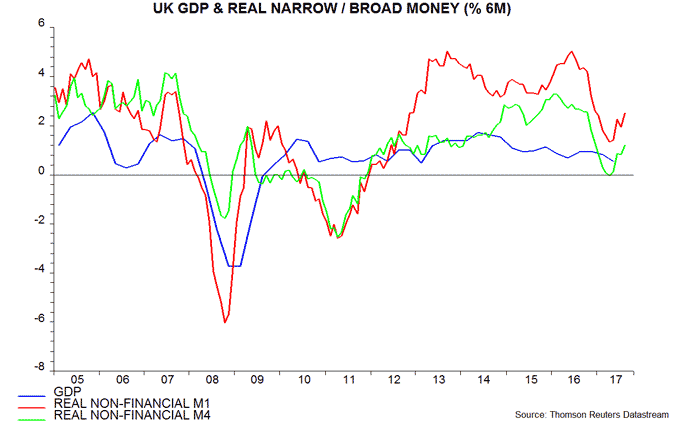Entries from September 24, 2017 - September 30, 2017
UK money trends improving
UK money trends have firmed since early 2017, suggesting that GDP growth will recover from its soft first-half pace.
Non-financial M1 – which, as in Euroland, outperforms other monetary aggregates as a leading indicator of the economy – rose by a solid 0.7% in August following a 0.4% July gain. Six-month growth bottomed in March and moved up to 3.7% or 7.5% annualised in August, very close to the Euroland pace – see first chart and previous post.

The broader non-financial M4 measure rose by 0.6% in August after 0.1% in July, while its six-month growth increased to 2.4% or 4.8% annualised – the fastest since December 2016.
The turnaround in six-month real (i.e. inflation-adjusted) money growth has been more pronounced because the six-month rate of increase of consumer prices (seasonally adjusted), while still elevated, has moderated from a peak in April – first and second charts. Real money growth, however, is lower than over 2014-16, suggesting that GDP expansion will remain subdued by recent standards.

The sectoral split of non-financial M1 supports a modestly positive interpretation, with growth of real money holdings of both households and private non-financial corporations (PNFCs) firming recently. Corporate growth is at a respectable level by historical standards, consistent with businesses maintaining expansion plans despite Brexit uncertainty.

The Office for National Statistics today released national accounts revisions through the second quarter of 2017 as well as July services output. GDP growth in the second quarter was unchanged at 0.3% but first-quarter expansion was revised up from 0.2% to 0.3%. Growth estimates for the third and fourth quarters of 2016, however, were lowered, i.e. the slowdown between the second half of 2016 and first half of 2017 was less pronounced than previously reported.
Services output fell by 0.2% in July from June. Incorporating previously-released data on industrial and construction output, July GDP was only 0.1% above the second-quarter level. July services weakness, however, was mostly accounted for by a fall in motion pictures output, which is volatile and now below its recent trend. Assuming a rebound in such output, GDP is probably still on course to meet the Bank of England staff's projection of 0.3% growth in the third quarter.
Euroland August money numbers better but trends cooling
Euroland money measures rebounded from July weakness in August. Six-month growth, however, has fallen since early 2017, suggesting that GDP expansion will moderate in late 2017 / early 2018.
Non-financial M1 – the monetary measure with the strongest historical forecasting record, according to ECB research – rose by 1.0% in August, following no change in July. The broader non-financial M3 measure was up by 0.6%, having fallen 0.1% in July*.
Six-month growth of non-financial M1 moved back up to 3.8% (7.7% annualised) – solid by historical standards but well down from a March peak of 5.6% (11.5% annualised). Non-financial M3 growth has also cooled since then. Bank lending expansion has been stable but is a coincident / lagging indicator of the economy (confirmed by the ECB research) – see first chart.

The monetary slowdown has been mild in real (inflation-adjusted) terms because of a simultaneous decline in the rate of increase of consumer prices (seasonally adjusted) over the spring and summer. Real money growth, however, has pulled back sufficiently to suggest a slowing of economic momentum in late 2017 / early 2018 – second chart. Six-month inflation, moreover, is likely to rebound, so real money trends may weaken further.

Robust GDP growth of 1.2% or 2.4% annualised during the first half of 2017 partly reflected strong net exports, which may face headwinds from a 7.2% rise in the euro effective exchange rate between December and August. Domestic demand rose by 0.6% or 1.3% annualised in the first half – third chart.

Real narrow money trends were much stronger in Euroland than the US in late 2016, suggesting superior economic prospects. GDP expanded by an annualised 2.4% in Euroland between the third quarter of 2016 and second quarter of 2017 versus 2.0% in the US. With US real non-financial M1 growth now back above the Euroland level, the US economy is likely to outperform in late 2017 / early 2018.

*Non-financial = held by households and non-financial corporations.

